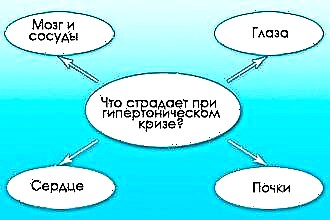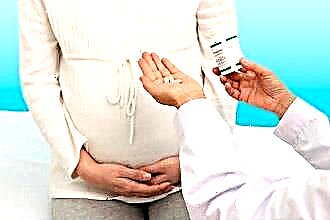Hypertension can provoke the onset of a dangerous condition that can cause severe damage to some internal organs of the victim - hypertensive crisis. Knowing the symptoms of the onset will help to recognize the disease in time and call doctors.
Symptoms
 What is a hypertensive crisis? The answer to this question is well known to many of those who are prone to arterial hypertension (that is, a regular increase in blood pressure). A hypertensive crisis is usually called the process of a strong and sharp increase in arterial blood pressure, which causes severe damage in the patient's body.
What is a hypertensive crisis? The answer to this question is well known to many of those who are prone to arterial hypertension (that is, a regular increase in blood pressure). A hypertensive crisis is usually called the process of a strong and sharp increase in arterial blood pressure, which causes severe damage in the patient's body.
It is interesting that the numbers can reach values of 220/120 mm. rt. Art. In this case, the symptoms in each case will be different: someone will feel severe malaise already at rates of 160/100 (as a rule, this applies to people with hypotension, that is, low blood pressure), and someone will be diagnosed with a hypertensive crisis only then when the indicators rise to values of 220/120 (these are, as a rule, people suffering from hypertension of the second - third degree).
Typical manifestations
In science, a hypertensive crisis is subdivided (classified) into several types:
| P / p No. | What is the basis for classifying | Name of the type of hypertensive crisis | Typical Symptoms |
|---|---|---|---|
| 1. | By the mechanism of increasing blood pressure | Hyperkinetic crisis (increased blood output by the heart - increased systolic pressure) | A sharp and severe headache, the presence of complaints in a hypertensive crisis of a hyperkinetic nature for dizziness, often nausea and vomiting, increased sweating, fever, increased heart rate and disturbance of its rhythm are superimposed on this. Occasionally, red spots may appear on the skin, and the skin may also become extremely moist. |
| Hypokinetic crisis (increased vascular resistance of the periphery - increased diastolic pressure) | Headache, impairment (to a large extent) of hearing and / or vision in a patient, sometimes bradycardia (that is, a decrease in heart rate) is recorded. | ||
| Eukinetic crisis (at the same time, the release of blood by the patient's heart increases, and the resistance of his peripheral vessels increases) | Signs of a hypertensive crisis of an eukinetic nature are implicitly expressed. It's all the same headache, general deterioration of health, nausea. | ||
| 2. | By the presence of lesions in a category of internal organs called targets | Uncomplicated crisis (proceeding without disturbances in the functioning of internal organs) | Sudden and pronounced headache with throbbing in the temples, sudden dizziness, disorientation in space, blurred vision. In addition, increased anxiety and nervous excitability, red spots on the patient's skin, cold sweat, and some internal tremor. |
| Complicated crisis (provoking disturbances in the functioning of the internal organs of a sick person) | Increased drowsiness of the patient, ringing in the ears, headache, heart pain in the patient, the presence of lethargy, the appearance of shortness of breath, severe visual or hearing impairment, frequent loss of consciousness, the presence of moist rales localized in the patient's lungs. | ||
| 3. | By which organ is affected (therefore, a hypertensive crisis is initially complicated) | Hypertensive cerebral (complications affecting the brain) | Dizziness and double vision (the picture captured by the patient's eyes, as it were, stratified), emotional instability, headache, being in an unconscious state. |
| Coronary crisis (only the coronary arteries that feed the human heart are affected) | Chest pain, nausea, weakness, a feeling of exhaustion, vomiting is possible, the appearance of "goose bumps". Sometimes the patient shivers. | ||
| Neurovegetative crisis (the cause of this form of the disease is the release of a large amount of adrenaline into the human bloodstream) | A headache of a throbbing nature, the possibility of dizziness and bouts of nausea, as well as increased nervous irritability of the patient, permanent anxiety, the presence of a slight increase in body temperature, chills and heavy sweating. | ||
| Edematous crisis (its cause is dysfunction of the body system, "responsible" for maintaining water balance in the body, as well as for stabilizing blood pressure) | Signs of a hypertensive crisis of this type of disease are uncharacteristic for other types of the disease - these are swelling of the limbs of a person, disorientation of the victim, the presence of severe headaches and muscle pains, loss of vision / hearing of the patient. | ||
| Convulsive crisis (lesions have affected the brain - the blood vessels feeding it) | The most obvious signs are convulsions, as well as loss of consciousness of a person in an attack, which is not recorded in other variations of a hypertensive crisis. Other symptoms include pain in the head and body, weakness, loss of strength, and nausea. |
However, with all the differences in the forms and varieties of the disease under study, among its most frequent symptoms (manifestations), the following can be distinguished:
- Headache, complaints of which are recorded in every second case.
- Dizziness of two types: appearing when moving the head (the cause is dystonia of the vertebral artery in the victim), and manifests itself even at rest of the patient (caused by dystonia of the carotid artery).
- General deterioration of the victim's condition.
- Nausea and frequent vomiting registered in the patient.
- Ringing and / or tinnitus.
- Shortness of breath experienced by the sick.
- Increased sweating.
- The appearance of "goose bumps" at normal air temperatures.
- Redness of the skin (in the form of spots) and so on.
Most importantly, a hypertensive crisis, in most cases, although not 100%, is provoked by hypertension (systematically high blood pressure).
Therefore, in the presence of this disease, a person is already at risk.
Of other reasons that can provoke its onset, the following are distinguished:
- Alcohol consumption by potential patients.
- Smoking and other bad habits.

- Frequent stress in a person's life.
- A sharp change in weather, especially associated with a change in atmospheric pressure.
- Excessive salt intake by hypertensive patients.
- Abrupt withdrawal of antihypertensive drugs (lowering blood pressure).
- Negative interaction of several medications taken at the same time.
- Rarely, a hypertensive crisis can be a side effect caused by the intake of a certain category of drugs, such as corticosteroids.
- Renal failure and some other causes.
Atypical syndromes
Often, the appearance of atypical symptoms of the aforementioned ailment clearly indicates that there has been a damage to any organs or their systems in the patient.
One of the atypical manifestations (as well as typical) is a neuralgic headache. Its main difference from the typical pain felt during a developing hypertensive crisis is that it affects only one half of the victim's head. Most often, such pain is recorded with disturbances in the functioning of the brain, possibly with swelling.
The next atypical symptom is back pain, often aching. The reason for the appearance of this symptom often lies in the fact that the disease is aggravated by a rupture of the aorta - an aneurysm, in which the walls of this vessel are stratified and blood flows between them.
Another symptom that is quite atypical for a "normal" hypertensive crisis is the appearance and growth of severe chest pain.
The cause of its appearance is heart ischemia or myocardial infarction, provoked by a hypertensive crisis.
The next atypical signs will be arrhythmia (disturbance of the patient's heartbeat rhythm) and paresthesia (violation of tactile sensitivity in the victim - numbness to complete loss of sensitivity of any areas of the skin, feeling of "goose bumps" and so on).
The first signs of the disease
As a rule, all forms of hypertensive crisis (with the exception of a convulsive crisis that comes suddenly) are accompanied by the appearance and increase of symptoms according to the following scheme: a headache appears that has a different character (from acute to slow-pulling, pulsating), then the general well-being of a person worsens, followed by " "dizziness" and the appearance of "flies" in the eyes are connected, sweating increases, deterioration of vision and hearing progresses, after which, depending on the form of hypertensive crisis, a person may lose consciousness / start to choke / convulse (due to oxygen starvation of the brain).
Further, depending on what type of disease is, the attack can grow gradually, up to several days, during which all the above symptoms are noted. In this case, the following manifestations are added to the list of symptoms: increased nervous irritability of a person, increased anxiety, spread of red spots throughout the body (especially on the arms and chest), impaired coordination of the patient.
Sometimes, on the contrary, an attack occurs abruptly, suddenly, and has serious consequences. This usually refers to a convulsive crisis (hypertensive encephalopathy). The consequences that it entails are different, but all equally severe: pulmonary or cerebral edema, cardiac asthma, acute heart failure, as well as myocardial infarction and stroke.
The end of an attack of a hypertensive crisis is often, according to the observations of the patients themselves, accompanied by increased urination, during which the urine is light, and sometimes transparent.
Severe form of the disease
 What are the manifestations of a severe form of this condition? And what is meant by the word "heavy"?
What are the manifestations of a severe form of this condition? And what is meant by the word "heavy"?
A severe crisis is any form of this disease that has or causes complications.
The most dangerous of them is the convulsive form, in medical science called acute hypertensive encephalopathy. This type of ailment occurs as a result of the dysfunction of the tone of the arterioles of the brain due to a sharp increase in blood pressure indicators. Characteristically, the victim has the following symptoms caused by prolonged (up to several days) cerebral edema:
- Severe headache, practically not relieved by drugs.
- Nausea as well as vomiting.
- Seizures of two types - clonic (frequent changes in muscle tone, that is, their twitching) and tonic (that is, fixed muscle tension - spasm); this feature is distinctive for this form of hypertensive crisis.
- Loss of consciousness by the victims.
- The victim's shortness of breath, and sometimes suffocation felt by him.
- Preservation for a certain time after the sick person regained consciousness, the spatial disorientation of the patient.
- Amnesia, diagnosed in a fairly large number of cases.
- Transient amaurosis is the temporary blindness of a patient who has recently undergone a hypertensive crisis, often caused by an impaired blood flow in the carotid artery.
Male and female crisis
In general, both men and women are prone to hypertensive crises. And the greatest danger in this regard is threatened by persons who have crossed the threshold of forty years: men in old age, as well as women in menopause. However, over the past decade, there has been some "rejuvenation" of the hypertensive crisis: more and more cases of its appearance in young people are recorded. The reason contributing to this has not yet been precisely established.
In addition, hypertension is a significant factor provocateur of a hypertensive crisis, but not necessary: this ailment is recorded in 30% of people with arterial hypertension. Moreover, women are more susceptible to the described disease.
In men, a hypertensive crisis is a little less common, and often it is caused by uncontrolled hypertension, due to the absence or incorrect / untimely administration of antihypertensive drugs.
Also, men at a relatively young age are prone to a hypertensive crisis of the neurovegetative type, caused by the release of a significant portion of adrenaline into the bloodstream. Moreover, in some cases, this disease is sometimes not diagnosed at all, since the symptoms do not "line up" for a man in a single picture of the disease, and therefore do not require a visit to a specialist, or is diagnosed after the onset of improvement. All this also contributes to the emergence of complications during the course of the attack.
As for women, they are very susceptible to the disease in question. And one of its most common forms is an edematous hypertensive crisis caused by excessive fluid intake, as well as salt and their reduced excretion from the body. A permanent increase in blood pressure also becomes a negative factor.
In addition, situations of "combining" a hypertensive crisis with atherosclerosis of blood vessels in menopausal women are often aggravated by the appearance of hot flashes - sensations of intense heat localized in the upper half of the body, often accompanied by reddening of the chest, neck, and face. At the same time, redness can have varying degrees of intensity: from subtle to beet red.
Thus, the symptomatology of a hypertensive crisis largely depends on the type of disease: complicated type of disease or not; hyperkinetic type of hypertensive crisis or another, in which place it is localized (coronary vessels or other area of localization), as well as from the course of the crisis and related factors.
At the same time, there are general, typical signs of the disease under study. These include, first of all, headache. It can have a different character and severity, however, it is most often localized in the occipital region and is characterized by pulsation in the temples.
Other typical symptoms include dizziness, discoordination of movements, visual and hearing impairment, increased sweating in the patient (the sweat that comes out will be sticky and cold), nausea, vomiting, the appearance of "goose bumps", regardless of the temperature factor in the environment, as well as complaints about shortness of breath, both when moving, but also at rest of the patient.
The appearance of two or more of the described symptoms in combination with the high blood pressure recorded by the victim himself, established using a conventional tonometer, indicates the need for immediate medical attention.




